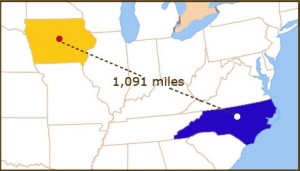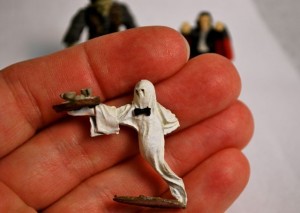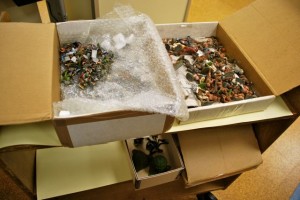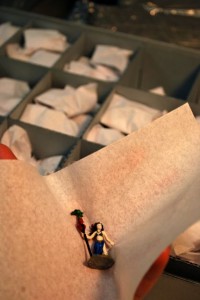 Only 117 days until Talk Like a Pirate Day. Arrrrrrrr!
Only 117 days until Talk Like a Pirate Day. Arrrrrrrr!
Monthly Archives: May 2012
1091 Project: AIC Annual Meeting And The 1091 Project
 This month on the 1091 project we look back to last week’s American Institute of Conservation’s Annual Conference. Melissa Tedone from Iowa State University (and co-conspirator of the 1091 Project) and I were part of a panel discussion called Communicating Conservation. The panel was put together by Nancie Ravenel from the Shelburne Museum and included myself, Melissa, Heidi Sobol from the Royal Ontario Museum, and Rosa Lowinger, conservator in private practice. A brief synopsis of the panel can be found on Conservators Converse thanks to Rose Cull.
This month on the 1091 project we look back to last week’s American Institute of Conservation’s Annual Conference. Melissa Tedone from Iowa State University (and co-conspirator of the 1091 Project) and I were part of a panel discussion called Communicating Conservation. The panel was put together by Nancie Ravenel from the Shelburne Museum and included myself, Melissa, Heidi Sobol from the Royal Ontario Museum, and Rosa Lowinger, conservator in private practice. A brief synopsis of the panel can be found on Conservators Converse thanks to Rose Cull.
Our presentation covered what social media we use, why we use it, our audiences, what assessment tools we use, and what good ideas we have developed including the 1091 Project. I want to share some of my observations from the discussion.
Mission Matters
Questions were raised: Is blogging “education” or “outreach”? Should we highlight our own work or should we teach best practices to the public? Are we talking to clients or to colleagues? I think we do all of the above to various degrees depending on our mission.
Duke University’s main mission is education. The Library’s mission is to support faculty and student research. Our Department’s mission is to make our resources available both now and in the future. We use social media to demonstrate to our library, university and the public how we support both the Library’s and the University’s missions. We also use these platforms to educate the public, and to have conversations with colleagues so that we, too, can learn and improve our programs.
This may not be the same mission as a conservator in private practice or someone who works in a museum and their use of social media may differ because of that. I do think there are many similarities in our missions and certainly the communication between colleagues is made easier through social media. Knowing your mission and your audience is key to successful blogging.
Audience: Intended and Real
Because the lab is in the lower level of our building behind a secured door our work sometimes feels secretive and hidden. When we first started this blog we wanted to show our library colleagues what we do and how we connect to their work and the library as a whole. The analysis of our stats showed that while we were being read by a few people within our library (mostly other bloggers), we were mainly being read by our conservation colleagues and the public.
This analysis lead to questions:
- How can we increase our readership within our library (beyond other bloggers)?
- How can we collaborate more with our colleagues across the country?
- What information should we be providing for the public?
- How do we serve all these readers in an effective and engaging way?
The first bullet point I’m still trying to improve. We are successfully blogging collaboratively with Devil’s Tale. Our “What’s In The Lab” series has been popular and allows both Devil’s Tale and Preservation Underground to reach new audiences.
The 1091 Project is a successful example of how we can collaborate with colleagues dispersed across a wide geographical area. I would love to hear ideas on how we can expand this collaborative blogging effort even further.
We provide information on best practices for preserving personal collections especially during Preservation Week. Our posts generally highlight what it is conservators do and I think simply presenting our projects is interesting to a wide variety of audiences.
Feedback
Still running through my mind is the issue of feedback. Melissa and I both receive a lot of great comments via email after each post. While we love to have these conversations privately, the point of social media is the online conversation between people. How can we encourage more feedback to our blogs? What kinds of posts would you like to see that would prompt more conversation?
There is much more to say and talk about and it was really fun to work with Melissa and the rest of the panel in person! Read Melissa’s post on Parks Library Preservation and for more conference coverage read updates on Conservators Converse and Preservation and Conservation Administration News (full disclosure, I am co-editor and author of PCAN).
New Exhibit: What’s missing from your video history?
Written by Liz Milewicz, Ph.D, Head of Digital Scholarship and Production Services. Exhibit curated by Liz Milewicz and Winston Atkins, Preservation Officer.
 Calling up my favorite Bert and Ernie sketches on YouTube makes it seem like there’s no problem with accessing my video history. But a brief glance behind the institutional curtains of digital preservation casts a cloud on how often I’ll be able to revisit such happy scenes.
Calling up my favorite Bert and Ernie sketches on YouTube makes it seem like there’s no problem with accessing my video history. But a brief glance behind the institutional curtains of digital preservation casts a cloud on how often I’ll be able to revisit such happy scenes.
Audio-visual materials’ rapid deterioration (relative to print media), its wide adoption for commercial and personal use, and the range of formats and playback equipment that rose and fell around analog videotape, have profound implications for preserving those pieces of our 20th century history that were captured on videotape.
“Generation Loss,” a new exhibit that I’ve co-curated with Winston Atkins, Preservation Officer, presents just a few of the many videotape formats introduced during the 20th century and collected in Duke University Libraries, as well as the signs of their deterioration and the factors that contribute to their loss. Because some of these signs are only visible when the tape is played, much of this loss goes unseen and unknown until someone tries to play the tape. The video display in this exhibit demonstrates some of common signs of audio-visual deterioration.
The exhibit is open during regular Perkins/Bostock hours. We are located on the Lower Level (same level as the Link), by Perkins Room 023. Come and have a look!
Pumpkinhead Bears, Dragons and Dracula – Oh My!

The Edwin and Terry Murray Collection of miniatures, aka The Most Fun Project In The Lab Ever, came in recently for enclosures. These lead figurines come from various role-playing games including Dungeons and Dragons. Over on Devil’s Tale you can read more about the processing of this collection.
The miniatures arrived in a variety of boxes as if the boys and girls had just finished playing with them. Opening the boxes felt like Christmas morning, I couldn’t wait to see what was inside. I think everyone in the lab got tired of me saying “Look at this one!” every five minutes but I couldn’t help it.

The figurines range in size from less than an inch to ten or more inches. You would think that these would be fairly robust being metal, but lead is soft and a lot of them are very fragile. Many have been painted and we know for sure some were painted by the Murray brothers themselves.
The figurines needed protection from rubbing against each other and plenty of cushioning to keep them from jostling around. They are also very heavy as a collection, so they needed to be boxed in a way that they could be lifted without throwing out your back.

My strategy was to wrap each in tissue and place them in modular artifact boxes. Each tray has twelve compartments, and each compartment holds on average four to six figurines depending on their size. The very large figurines were put into custom-built trays. I did my best to keep like-themed characters together so people interested in animals or dragons or warriors should be able to find what they are looking for. Admittedly, users may find this system cumbersome but if these start receiving very high use, I can revisit my boxing decision in consultation with Research Services.
There are many, many pictures on our Flickr site that shows more of the boxing process and some of my favorite characters including the above mentioned Pumpkinhead Bear and many, many dragons (my favorite creatures of all). Be sure to check out the skeletal dragon, she has amazing detail and is so very fragile. She also has a broken wing but it is there with her in her box.

I’m a little sad to see these leave the lab because it was so much fun to work on. But I know that they are now well protected and will be there for anyone to use in the future, maybe even me.
May Day: Occupy Your Disaster Plan
 Happy May Day! Today, we will be welcoming the coming of spring by dancing around the May Pole and celebrating International Workers Day. Since May Day is also the traditional day to prepare for an emergency in your cultural institution, we will also be making sure we are ready in our library.
Happy May Day! Today, we will be welcoming the coming of spring by dancing around the May Pole and celebrating International Workers Day. Since May Day is also the traditional day to prepare for an emergency in your cultural institution, we will also be making sure we are ready in our library.
Disasters often strike with little or no warning. Waiting until a water pipe bursts or a hurricane hits is not a disaster plan. Today we invite you to do one thing to prepare for an emergency. If you don’t know where to start, we have some ideas for you below and in previous posts. Pick one, any one, just do something to prepare for an emergency today.
Do One Thing
- Download the new Heritage Preservation Emergency Response and Salvage Wheel iPhone app on your iPhone. It’s free!
- If you don’t have a smart phone, buy a copy of the Field Guide to Emergency Response and the Salvage Wheel. The combo is on sale through May 31st for $25.95, that’s less than the member rate! This is an excellent resource to help you get your disaster plan together and to respond to any emergency in your collections.
- Check your disaster kit. Do you need to restock or replace anything? Do you have a pair of warm socks in there? [I still haven’t replaced my respirator, bad conservator!]
- Review your emergency phone tree. Are the correct people listed and the phone numbers still correct? For those of you in the 919 area code, put a reminder in your document that you now need to dial the 919 area code for local numbers.
- Review your plan. What’s missing or needs updating? You don’t have to make those changes today, but make an appointment on your calendar to do it…then DO it!
- If you are not the one responsible for disaster planning or recovery in your institution, find out who is and ask for a copy of the disaster plan. And remember, if it is in electronic form, be sure to print out a copy and take it home. The internet doesn’t work when the power is out and cell phone towers are down.
- And don’t forget you need a plan at home, too. The Red Cross has some good information on how to put a disaster kit together for your home and family.
Thanks to Heritage Preservation and their efforts over the years to raise awareness of the need for disaster planning and recovery training in cultural institutions. Be sure to check out their home page, and friend them on Face Book.
Now…back to the dancing.

